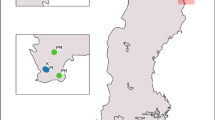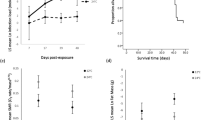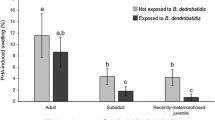Abstract
The amphibian chytrid fungus, Batrachochytrium dendrobatidis (Bd), has been linked to amphibian declines and extinctions worldwide. The pathogen has been found on amphibians throughout eastern North America, but has not been associated with mass die-offs in this region. In this study, we conducted laboratory experiments on the effects of Bd infection in a putative carrier species, Lithobates pipiens, using two estimators of fitness: jumping performance and testes morphology. Over the 8-week study period, peak acceleration during jumping was not significantly different between infected and uninfected animals. Peak velocity, however, was significantly lower for infected animals after 8 weeks. Two measures of sperm production, germinal epithelium depth, and maximum spermatic cyst diameter, showed no difference between infected and uninfected animals. The width, but not length, of testes of infected animals was significantly greater than in uninfected animals. This study is the first to show effects on whole-organism performance of Bd infection in post-metamorphic amphibians, and may have important long-term, evolutionary implications for amphibian populations co-existing with Bd infection.



Similar content being viewed by others
References
Able DJ (1999) Scramble competition selects for greater tailfin size in male red-spotted newts (Amphibia: Salamandridae). Behavioral Ecology and Sociobiology 46:423-428
Adolph SC, Pickering T (2008) Estimating maximum performance: effects of intraindividual variation. Journal of Experimental Biology 211:1336-1343
Arnold S J (1983) Morphology, performance and fitness. American Zoologist 23:347-361
Bonneaud C, Mazucj J, Chastel O, Westerdahl H, Sorci G (2004) Terminal investment induced by immune challenge and fitness traits associated with major histocompatibility complex in the House Sparrow. Evolution 58:2823-2830
Boyle DG, Boyle DB, Olsen V, Morgan JAT, Hyatt AD (2004) Rapid quantitative detection of chytridiomycosis (Batrachochytrium dendrobatidis) in amphibian samples using real-time Taqman PCR assay. Diseases of Aquatic Organisms 60:141-148
Carey C, Bruzgul JE, Livo LJ, Walling ML, Kuehl KA, Dixon BF, Pessier AP, Alford RA, Rogers KB (2006) Experimental exposures of boreal toads (Bufo boreas) to a pathogenic chytrid fungus (Batrachochytrium dendrobatidis). EcoHealth 3:5-21
Carey C, Cohen N, Rollins-Smith L (1999) Amphibian declines: an immunological perspective. Developmental and Comparative Immunology 23:459-472
Chatfield MC, Moler P, Richards-Zawacki CL (2012) The amphibian chytrid fungus, Batrachochytrium dendrobatidis, in fully aquatic salamanders from southeastern North America. PLoS One 7:e44821
Christian KA, Tracy CR (1981) The effect of the thermal environmental on the ability of hatchling Galapagos land iguanas to avoid predation during dispersal. Oecologia 49:218-223
Clutton-Brock TH (1984) Reproductive effort and terminal investment in iteroparous animals. The American Naturalist 12:212-229
Gaertner JP, Gaston MA, Spontak D, Forstner MRJ, Dahn D (2009) Seasonal variation in the detection of Batrachochytrium dendrobatidis in a Texas population of Blanchard’s Cricket Frog (Acris crepitans blanchardi). Herpetological Review 40:184-187
Gahl MK, Longcore JE, Houlahan JE (2011) Varying responses of northeastern North American amphibians to the chytrid pathogen Batrachochytrium dendrobatidis. Conservation Biology 26:135-141
Garland S, Baker A, Phillott AD, Skerratt LF (2010) BSA reduces inhibition in a TaqMan® assay for the detection of Batrachochytrium dendrobatidis. Diseases of Aquatic Organisms 92:113-116
Ghalambor CK, Walker JA, Reznick DN (2003) Multi-trait selection, adaptation, and constraints on the evolution of burst swimming performance. Integrative and Comparative Biology 43:431-438
Goater CP, Semlitsch RD, Bernasconi MV (1993) Effects of body size and parasite infection on the locomotory performance of juvenile toads, Bufo bufo. Oikos 66:129-136
Grooms DL (2004) Reproductive consequences of infection with bovine viral diarrhea virus. Food Animal Practice 20:5-19
Hayat MA (1993) Stains and cytochemical methods, New York: Plenum Press
Hesketh H, Gibbs M, Breuker CJ, Van Dyck H, Turner E, Hails RS (2012) Exploring sub-lethal effects of exposure to a nucleopolyhedrovirus in the speckled wood (Pararge aegeria) butterfly. Journal of Invertebrate Pathology 109:165-168
Holem RR, Hopkins WA, Talent LG (2006) Effect of acute exposure to malathion and lead on sprint performance of the western fence lizard (Sceloporus occidentalis). Archives of Environmental Contamination and Toxicology 51:111-116
Hunt J, Bussieré LF, Jennions MD, Brooks R (2004) What is genetic quality? Trends in Ecology and Evolution 19:329-333
Hunt J, Breuker CJ, Sadowski JA, Moore AJ (2009) Male-male competition, female mate choice and their interaction: determining total sexual selection. Journal of Evolutionary Biology 22:13-26
Husak JF, Fox SF (2008) Sexual selection on locomotor performance. Evolutionary Ecology Research 10:213-228
Husak JF, Fox SF, Lovern MB, Van Den Bussche RA (2006) Faster lizards sire more offspring: Sexual selection on whole-animal performance. Evolution 60:2122-2130
Jones ME, Cockburn A, Hamede R, Hawkins C, Hesterman H, Lachish S, Mann D, McCallum H, Pemberton D (2008) Life-history changes in disease-ravaged Tasmanian devil populations. Proceedings of the National Academy of Sciences 105:10023-10027
Kinney VC, Heemeyer JL, Pessier AP, Lannoo MJ (2011) Seasonal pattern of Batrachochytrium dendrobatidis infection and mortality in Lithobates areolatus: Affirmation of Vredenberg’s “10,000 Zoospore Rule”. PLoS One 6:1-10
Lailvaux S, Kasumovic MM (2011) Defining individual quality over lifetimes and selective contexts. Proceedings of the Royal Society B–Biological Sciences 278:321-328
Lailvaux SP, Irschick DJ (2006) A functional perspective on sexual selection: insights and future prospects. Animal Behaviour 72:263-273
Latorre-Margarlef N, Gunnarsson G, Munster VJ, Fouchier RAM, Osterhaus ADME, Elmberg J, Olsen B, Wallenston A, Haemig PD, Fransson T, Brudin L, Waldenström J (2009) Effects of influenza A virus infection on migrating mallard ducks. Proceedings of the Royal Society B–Biological Sciences 276:1029-1036
Lips KR, Burrowes PA, Mendelson III JR, Parra-Olea G (2005) Amphibian population declines in Latin America: A synthesis. Biotropica 37:222-226
Lochmiller RL, Deerenberg C (2000) Trade-offs in immunology: just what is the cost of immunity? Oikos 88:87-98
Longcore JR, Longcore JE, Pessier AP, Halteman WH (2007) Chytridiomycosis widespread in anurans of northeastern United States. Journal of Wildlife Management 71:435-444
Losos JB, Creer DA, Schulte JA (2002) Cautionary comments on the measurement of maximum locomotor capabilities. Journal of Zoology 258:57-61
Martin J (1996) Effects of recent feeding on locomotor performance of juvenile Psammodromus algirus lizards. Functional Ecology 10:390-395
McCallum ML, Trauth SE (2007) Physiological trade-offs between immunity and reproduction in the Northern Cricket Frog (Acris crepitans). Herpetologica 63:269-274
Murray KA, Skerratt LF, Speare R, McCallum H (2009) Impact and dynamics of disease in species threatened by the amphibian chytrid fungus, Batrachochytrium dendrobatidis. Conservation Biology 23:1242-1252
Oppliger A, Celerier ML, Clobert J (1996) Physiological and behavior changes in common lizards parasitized by haemogregarines. Parasitology 113:433-438
Paetow LJ, McLaughlin JD, Cue RI, Pauli BD, Marcogliese DJ (2012) Effects of herbicides and the chytrid fungus Batrachochytrium dendrobatidis on the health of post-metamorphic northern leopard frogs (Lithobates pipiens). Ecotoxicology and Environmental Safety 80:372-380
Parris MJ, Cornelius TO (2004) Fungal pathogen causes fungal and developmental stress in larval amphibian communities. Ecology 85:3385-3395
Parris MJ, Reese E, Storfer A (2006) Antipredator behavior of chytridiomycosis-infected northern leopard frog (Lithobates pipiens) tadpoles. Canadian Journal of Zoology 84:58-65
Phillips BL, Brown GP, Webb JK, Shine, R. (2006) Invasion and the evolution of speed in toads. Nature 439:803
Ramsey JP, Reinert LK, Harper LK, Woodhams DC, Rollins-Smith LA (2010) Immune defenses against Batrachochytrium dendrobatidis, a fungus linked to global amphibian declines, in the South African clawed frog, Xenopus laevis. Infection and Immunity 78:3981-3992
Retallick RWR, Miera V (2007) Strain differences in the amphibian chytrid Batrachochytrium dendrobatidis and non-permanent, sub-lethal effects of infection. Diseases of Aquatic Organisms 75:201-207
Richard EA, Fortier GD, Pitel P-H, Dupuis M-C, Valette J-P, Art T, Denoix J-M, Lekeux PM, Van Erck E (2010) Sub-clinical diseases affecting performance in Standardbred trotters: Diagnostic methods and predictive parameters. The Veterinary Journal 184:282-289
Rothermel BE, Walls SC, Mitchell JC, Dodd CK, Irwin LK, Green DE, Vazquez VM, Petranka JW, Stevenson DJ (2008) Widespread occurrence of the amphibian chytrid fungus Batrachochytrium dendrobatidis in the southeasten USA. Diseases of Aquatic Organisms 82:3-18
Saglam IK, Roff DA, Fairbairn DJ (2008) Male sand crickets trade-off flight capability for reproductive potential. Journal of Evolutionary Biology 21:997-1004
Schmid-Hempel P (2003) Variation in immune defence as a question of evolutionary ecology. Proceedings of the Royal Society B–Biological Sciences 270:357-366
Skerratt LF, Berger L, Speare R, Cashins S, McDonald KR, Phillott AD, Hines HB, Kenyon N (2007) Spread of chytridiomycosis has caused the rapid global decline and extinction of frogs. EcoHealth 4:125-134
Stearns SC (1989) Trade-offs in life-history evolution. Functional Ecology 3:259-268
Toro E, Herrel A, Vanhooydonck B, Irschick DJ (2003) A biomechanical analysis of intra- and inter-specific scaling of jumping and morphology in Caribbean Anolis lizards. Journal of Experimental Biology 206:2641-2652
Toro E, Herrel A, Irschick DJ (2004) The evolution of jumping performance in Caribbean Anolis lizards: solutions to biomechanical trade-offs. The American Naturalist 163:844-856
Trombulak SC (1989) Running speed and body mass in Belding’s ground squirrels. Journal of Mammalogy 70:194-197
Uller T, Isaksson C, Olsson M (2006) Immune challenge reduces reproductive output and growth in a lizard. Functional Ecology 20:873-879
van Gils JA, Munster VJ, Radersma R, Liefhebber D, Fouchier RAM, Klaassen M (2007) Hampered foraging and migratory performance in swans infected with low-pathogenic avian influenza A virus. PLoS One 2:e184
Velando A, Drummond H, Torres R (2006) Senescent birds redouble reproductive effort when ill: confirmation of the terminal investment hypothesis. Proceedings of the Royal Society B–Biological Sciences 273:1443-1448
Venesky MD, Parris MJ, Storfer A (2009) Impacts of Batrachochytrium dendrobatidis infection on tadpole foraging performance. EcoHealth 6:565-575
Vervust B, Lailvaux SP, Grbac I, Van Damme R (2008) Do morphological condition indices predict locomotor performance in the lizard Podarcis sicula? Acta Oecologica 34:244-251
Voordouw MJ, Adama D, Houston B, Govindarajulu P, Robinson J (2010) Prevalence of the pathogenic chytrid fungus, Batrachochytrium dendrobatidis, in an endangered population of northern leopard frogs, Rana pipiens. BMC Ecology 10:6
Woodhams DC, Hyatt AD, Boyle DG, Rollins-Smith L (2008) The Northern Leopard Frog Lithobates pipiens is a widespread reservoir species harboring Batrachochytrium dendrobatidis in North America. Herpetological Review 39:66-68
Zera AJ, Harshman LG (2001) The physiology of life-history trade-offs in animals. Annual Review of Ecology and Systematics 32:95-126
Acknowledgments
We thank K. Bain, J. Edwards and M. Hinton for help in the lab, and D. Sever and T. Sherry for use of their histological facilities. This study was funded largely by a grant to MWHC from the Louisiana Department of Wildlife and Fisheries, and was carried out in accordance with the Institutional Animal Care and Use Committees of Tulane University (protocol number 0413) and the University of New Orleans (protocol number 11-003).
Author information
Authors and Affiliations
Corresponding author
Rights and permissions
About this article
Cite this article
Chatfield, M.W.H., Brannelly, L.A., Robak, M.J. et al. Fitness Consequences of Infection by Batrachochytrium dendrobatidis in Northern Leopard Frogs (Lithobates pipiens). EcoHealth 10, 90–98 (2013). https://doi.org/10.1007/s10393-013-0833-7
Received:
Revised:
Accepted:
Published:
Issue Date:
DOI: https://doi.org/10.1007/s10393-013-0833-7




